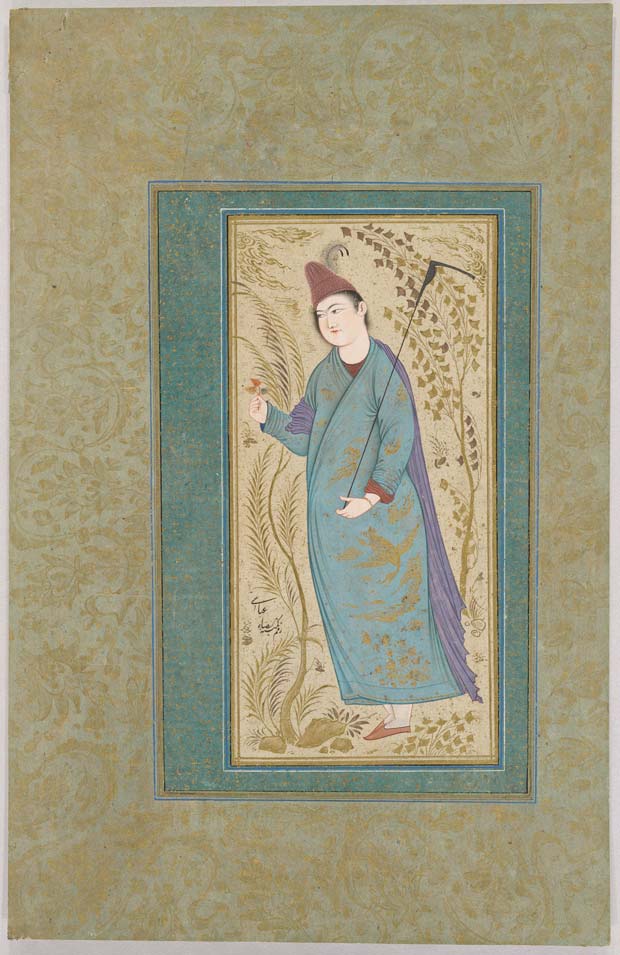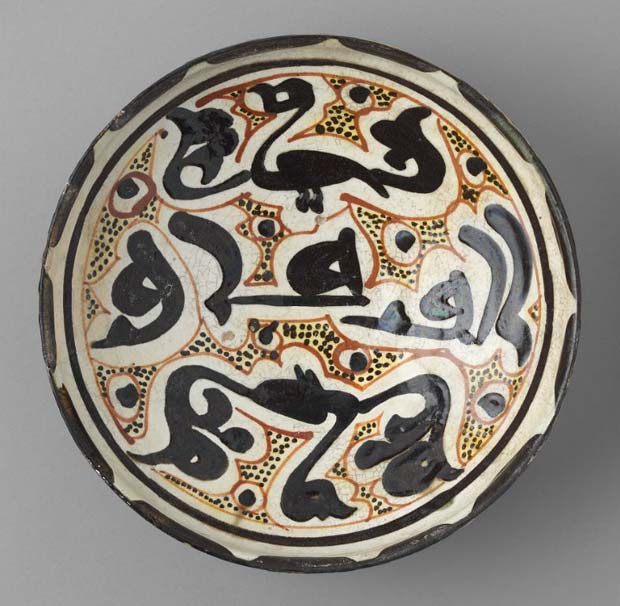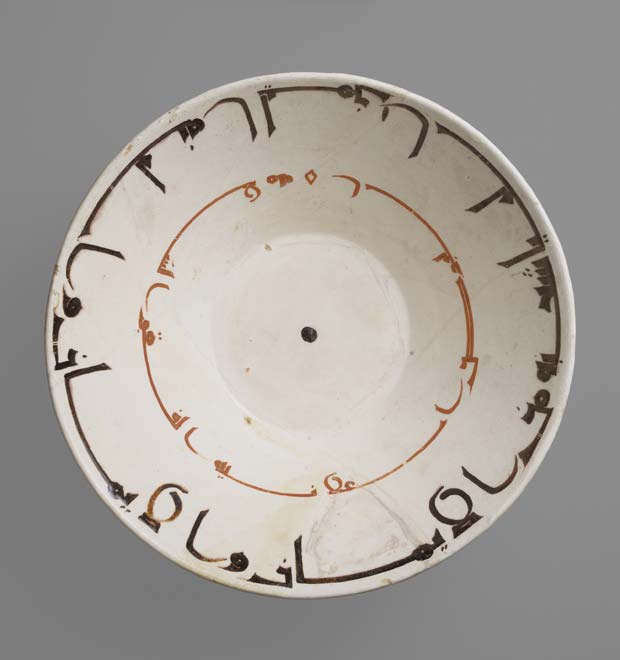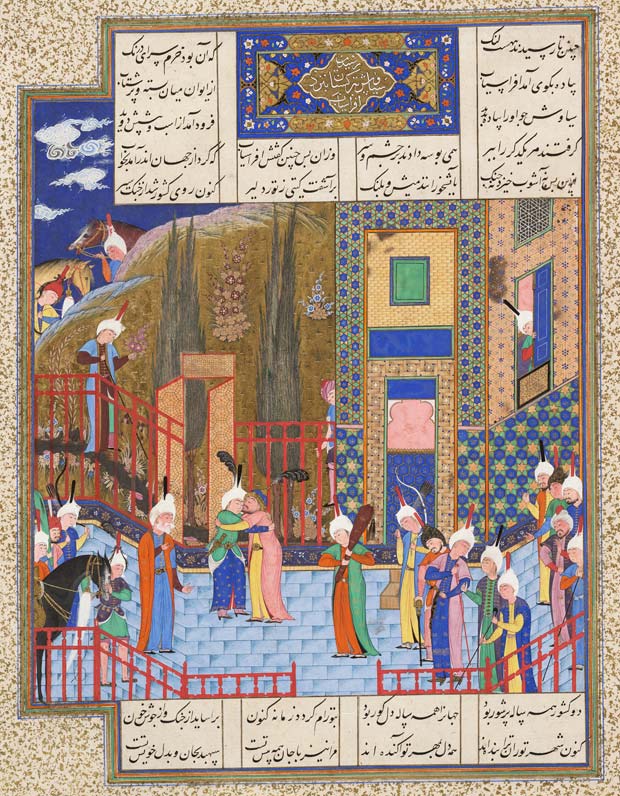
EXHIBITION In Harmony: The Norma Jean Calderwood Collection of Islamic Art
Dec 18, 2012 FEATURE, Art Collection

The Harvard Art Museums presents 'In Harmony: The Norma Jean Calderwood Collection of Islamic Art', a special exhibition that showcases some 150 objects from the Persian cultural sphere, including luxury glazed ceramics of the early and medieval Islamic era, illustrated manuscripts of medieval epic poems, and lacquerware of the early modern era. The works in this little-known and largely unpublished collection represent 30 years of committed collecting by Mrs. Calderwood. 'In Harmony' is on display January 31 - June 1, 2013 at the Harvard Art Museums/Arthur M. Sackler Museum, 485 Broadway, Cambridge, MA.
The exhibition is curated by Mary McWilliams, Norma Jean Calderwood Curator of Islamic and Later Indian Art, Division of Asian and Mediterranean Art, Harvard Art Museums. An accompanying catalogue, edited by McWilliams, offers illustrated entries and nine essays written by distinguished scholars and conservation scientists from a broad range of specialties.
“In the decade since the Harvard Art Museums received the Norma Jean Calderwood Collection of Islamic Art, our gratitude has only increased for this magniï¬cent gift,†said McWilliams. “Our research on the collection has inspired an even greater admiration and respect for Norma Jean’s knowledge and achievement. With this exhibition and catalogue, we hope to share with a broader audience the understanding we have gained of this beautiful and thoughtfully formed collection.â€
“There has been exponential growth in the study of Islamic art in recent decades,†said Thomas W. Lentz, Elizabeth and John Moors Cabot Director of the Harvard Art Museums, “and Harvard University and the Harvard Art Museums have been at the forefront of this movement, with faculty, curators, students, and celebrated collections providing fertile ground for the ï¬eld. The Calderwood Collection is a lasting contribution from a collector who understood the heart of our educational mission.â€
 Riza Ê¿Abbasi, Young Dervish, folio from an album / Iran, Safavid period, c. 1630. Ink, opaque watercolor, and gold on paper. Harvard Art Museums/Arthur M. Sackler Museum, The Norma Jean Calderwood Collection of Islamic Art, 2002.50.19 / Courtesy of Harvard Art Museums
Riza Ê¿Abbasi, Young Dervish, folio from an album / Iran, Safavid period, c. 1630. Ink, opaque watercolor, and gold on paper. Harvard Art Museums/Arthur M. Sackler Museum, The Norma Jean Calderwood Collection of Islamic Art, 2002.50.19 / Courtesy of Harvard Art Museums
Norma Jean Calderwood devoted much of her life to studying and teaching Islamic art and the complex of cultures in which it arose. She pursued graduate study in Islamic art at Harvard University, where she specialized in Persian manuscripts, and taught for many years at the Museum of Fine Arts, Boston, and at Boston College. A gifted lecturer, she was also an intrepid traveler, crossing North Africa, the Middle East, and Central Asia to study the art and architecture of Islamic lands. For three decades beginning in 1968, she systematically acquired examples of the artistic tradition that captivated her.
Stanford and Norma Jean Calderwood were energetic and generous philanthropists in their adopted city of Boston. Institutions that have beneï¬ted directly from the Calderwoods’ generosity include the Boston Athenaeum, Boston College, the Cambridge Art Association, the Harvard Art Museums, the Huntington Theatre, the Isabella Stewart Gardner Museum, the MacDowell Colony (Peterborough, NH), the Museum of Fine Arts, Boston, and public broadcaster WGBH. Their private art collection was the most tangible and personal expression of the Calderwoods’ lifelong involvement in the arts, but also the one least known to the public.
The Calderwood Collection covers more than a thousand years of artistic achievement in the Persian world during the Islamic era, principally through the media of ceramics, works on paper, and lacquer. The majority of objects were produced between the 9th and 19th centuries in Iran, Iraq, and parts of Central Asia. Initially attracted to luxury ceramics, Norma Jean Calderwood amassed 57 examples within a decade before shifting her attention to works on paper—illuminated and illustrated manuscript folios as well as single-page compositions. A handful of lacquer objects rounds out the collection. The collection was gifted to the Harvard Art Museums in 2002, and a subsequent exhibition of 46 objects, titled Closely Focused, Intensely Felt: Selections from the Norma Jean Calderwood Collection of Islamic Art, was held August 7, 2004–January 2, 2005 at the Sackler Museum. That exhibition marked the ï¬rst public showing of a major portion of the collection.
To convey to her students the effect of a Persian painting, Norma Jean Calderwood said that its many visual elements “united to form a harmony.†The theme is eloquently expressed in some of the ï¬nest works in the Calderwood Collection, as well as in the total assembly, with objects resonating through contrasts and connections. This exhibition celebrates the scope of Calderwood’s achievement and the harmony of purposes that led to the gifting of the collection to the Harvard Art Museums.
To reflect the collection’s breadth and variety, the exhibition is ordered along a flexible chronology, beginning with earthenware from the 9th and 10th centuries, and closing with lacquerware from the 19th and early 20th centuries. Interspersed are several thematic clusters, as well as groupings of folios from four illustrated manuscripts that Mrs. Calderwood endeavored to reassemble when they were dispersed on the art market.
Bowl with rooster and ï¬sh (Iraq, Basra, 10th century) is decorated with luster painting, the greatest contribution of Islamic potters to the history of ceramics. Bowl inscribed with sayings of the Prophet Muhammad and Ê¿Ali ibn Abi Talib (Uzbekistan, Samarkand, 10th century), a superb example of epigraphic wares, bears Arabic inscriptions attributed to two of the most important ï¬gures in the history of Islam. The decoration of arabesques and interlaced lines on Bowl with radial interlace design (Iran, Kashan, late 12th–early 13th century), is created in the polychrome mina’i technique—a costly and complex overglaze process that required multiple ï¬rings. The colorful decoration on Bowl with inscription and birds (Iran, Nishapur, 10th century) is carefully composed and laid out in three registers: an Arabic word meaning “harmony†(al-wifaq) occupies the middle, and above and below it are long-necked birds with outstretched wings.
 Bowl with inscription and birds / Iran, Nishapur, Samanid period, 10th century. earthenware covered in slip and painted under glaze. Harvard Art Museums/Arthur M. Sackler Museum, The Norma Jean Calderwood Collection of Islamic Art, 2002.50.92. Photo: Harvard Art Museums / Courtesy of Harvard Art Museums
Bowl with inscription and birds / Iran, Nishapur, Samanid period, 10th century. earthenware covered in slip and painted under glaze. Harvard Art Museums/Arthur M. Sackler Museum, The Norma Jean Calderwood Collection of Islamic Art, 2002.50.92. Photo: Harvard Art Museums / Courtesy of Harvard Art Museums
 Bowl inscribed with sayings of the Prophet Muhammad and Ê¿Ali ibn Abi Talib, Uzbekistan, Samarkand, Samanid period, 10th century. Earthenware covered in slip and painted under glaze. Harvard Art Museums/Arthur M. Sackler Museum, The Norma Jean Calderwood Collection of Islamic Art, 2002.50.88 / Courtesy of Harvard Art Museums
Bowl inscribed with sayings of the Prophet Muhammad and Ê¿Ali ibn Abi Talib, Uzbekistan, Samarkand, Samanid period, 10th century. Earthenware covered in slip and painted under glaze. Harvard Art Museums/Arthur M. Sackler Museum, The Norma Jean Calderwood Collection of Islamic Art, 2002.50.88 / Courtesy of Harvard Art Museums
The works on paper include illustrated manuscripts of medieval Persian poems, most notably the Shahnama (Book of Kings) by Firdawsi, and the Khamsa (Quintet) by Nizami. A painting of great importance is Afrasiyab and Siyavush Embrace, from one of the most celebrated illustrated manuscripts in Islamic art—a large-scale and lavish copy of the Shahnama that was created in Tabriz, Iran, c. 1520–40 for Shah Tahmasp I, the second ruler of the Safavid dynasty in Iran. This brilliant painting illustrates a rare moment of harmony between the warring peoples of Iran and Turan. From another manuscript of the Shahnama comes Solomon Enthroned (c. 1575–90), one of the Calderwood Collection’s ï¬nest examples of painting from the Iranian city of Shiraz, which for three centuries was a major center for the production of illuminated and illustrated manuscripts. This painting depicts the famously multilingual King Solomon presiding wisely over an incongruous retinue of humans, demons, angels, and animals. The rising importance of single-page compositions is reflected in Young Dervish (Iran, Isfahan, c. 1630) which shows a comely youth sporting the domical wool hat and staff of a dervish. Signed by Riza `Abbasi, the most influential artist of 17th-century Iran, the painting demonstrates his calligraphic draftsmanship and subtle sense of color. Midway through the exhibition several of the works on paper will be rotated. Those works will be on view beginning Tuesday, April 9, 2013.
 Afrasiyab and Siyavush Embrace, folio from a manuscript of the Shahnama by Firdawsi / Iran, Tabriz, Safavid period, 1520–40. Ink, opaque watercolor, gold, and silver on paper. Harvard Art Museums/Arthur M. Sackler Museum, The Norma Jean Calderwood Collection of Islamic Art, 2002.50.13 / Courtesy of Harvard Art Museums
Afrasiyab and Siyavush Embrace, folio from a manuscript of the Shahnama by Firdawsi / Iran, Tabriz, Safavid period, 1520–40. Ink, opaque watercolor, gold, and silver on paper. Harvard Art Museums/Arthur M. Sackler Museum, The Norma Jean Calderwood Collection of Islamic Art, 2002.50.13 / Courtesy of Harvard Art Museums
In Harmony marks the ï¬rst time the Harvard Art Museums are exploring the use of augmented reality technology. After downloading an app called Layar on to an iPhone, iPad, or Android mobile device, visitors to the exhibition can point their device at any of the six designated objects in the gallery, and additional content will appear. Content may include photomicrographs from the object’s conservation treatment, comparative images in other collections, or video showing the recreation of a vessel’s construction. The free app can be downloaded at the Apple App Store, the Android Apps section of the Google Play store, and on the Layar website. A small number of devices may be borrowed at the admissions desk on the ï¬rst floor of the Sackler Museum.
This exhibition and its accompanying catalogue have been made possible through the generous support of the late Stanford Calderwood.
The Harvard Art Museums, among the world’s leading art institutions, comprise three museums (Fogg, Busch-Reisinger, and Arthur M. Sackler) and four research centers (Straus Center for Conservation and Technical Studies, the Center for the Technical Study of Modern Art, the Harvard Art Museums Archives, and the Archaeological Exploration of Sardis). The Harvard Art Museums are distinguished by the range and depth of their collections, their groundbreaking exhibitions, and the original research of their staff. The collections include approximately 250,000 objects in all media, ranging in date from antiquity to the present and originating in North America, South America, Europe, Africa, the Middle East, and Asia. Integral to Harvard University and the wider community, the art museums and research centers serve as resources for students, scholars, and other visitors. For more than a century they have been the nation’s premier training ground for museum professionals and are renowned for their seminal role in developing the discipline of art history in this country.
Comments
Add a comment